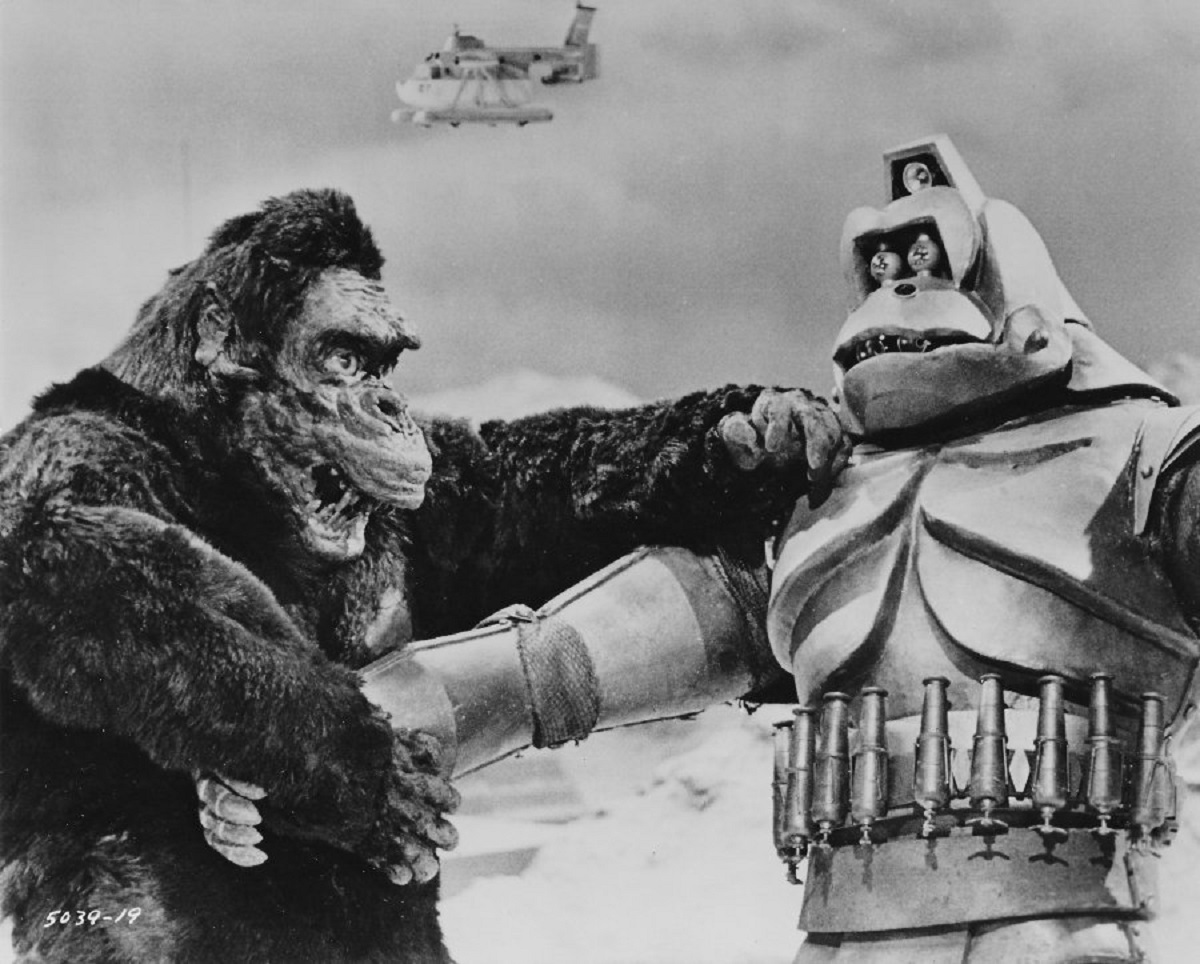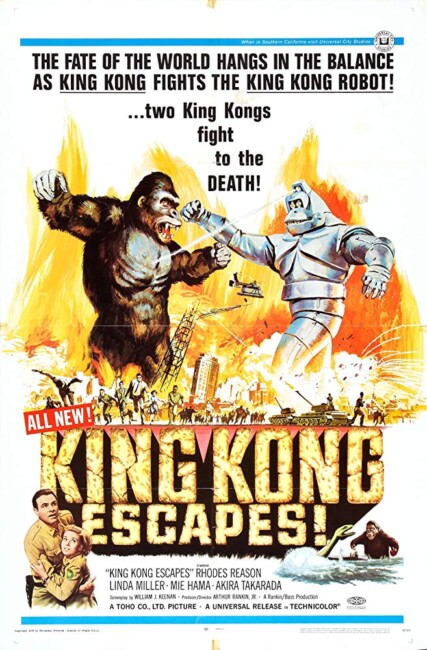(Kingukongu no Gyakushu)
Japan. 1967.
Crew
Director – Ishiro Honda, US Version Director/Producer – Arthur Rankin Jr, Screenplay – Kaoru Maabuchi, US Version Screenplay – William J. Keenan, Producer – Tomoyuki Tanaka, Photography – Hajime Koizumi, Music – Akira Kfukube, Director of Special Effects Photography – Eiji Tsuburaya, Production Design – Takeo Kita. Production Company – Toho.
Cast
Rhodes Reason (Commander Carl Nelson), Linda Miller (Lieutenant Susan Watson), Mie Hama (Madame X), Eisei Amamoto (Dr Who), Akira Takarada (Lieutenant Jiro Namura)
Plot
The submarine Explorer, commanded by Carl Nelson, comes upon Mondo Island where they find King Kong alive. Kong takes a liking to the ship’s nurse Susan Watson. As soon as news of Kong’s existence hits the world, Kong is abducted by Dr Who, a scientist in the employ of a foreign country, who is attempting to perfect his own robot version of Kong in order to dig for Element X and create weapons.
King Kong (1933) is the greatest of all monster movies. Many films have followed using Kong’s name – from Ernest B. Schoedsak and Willis O’Brien’s official sequel The Son of Kong (1933) to these Japanese-made sequels from Toho Studios, to Dino De Laurentiis’s infamous remake King Kong (1976) and its laughable sequel King Kong Lives (1986). However, these were all pallid imitators that failed to grant Kong any of his original majesty, at least up until Peter Jackson’s fabulous remake King Kong (2005).
Toho began their sequels with King Kong Vs. Godzilla (1962), which paired Kong up against Godzilla in one of the great monster bash title matches of the century. They then sequelized King Kong Vs. Godzilla with King Kong Escapes, which came minus the Big G. There is a laughable ineptitude to the shabbiness to Toho’s Kong – Kong is another of their men in a moth-eaten monster suit and comes with ridiculously inexpressive cartoon eyes.
At the same time, there is a frequent innocence to Toho’s films that makes it all rather inoffensive. The scenes with Kong engaged in a wrestling match with a dinosaur and the city-destroying mass destruction climax against the robot Kong has a colourful child-like appeal. Especially amusing is the heroine’s relationship with the ape – rather than, as it was in King Kong, a fragile romance that verges on a fairytale, here it is more like a girl with a 40-foot puppy dog. “Go after the ship,” she orders him at one point. Seemingly unaware of the coincidence of the name of the long running British tv series Doctor Who (1963-89, 2005– ), the film has a super-villain named Dr Who.

Like many Japanese monster movies of the 1960s, King Kong Escapes has scenes filmed with American actors for English-language release. What is odious about the version that comes from Arthur Rankin is that Arthur Rankin Jr has not only overseen such scenes but also added credits to give the appearance that he directed the film and that the Japanese only contributed additional scenes. In actuality, the entire film was directed by Ishiro Honda and all that Arthur Rankin Jr did was oversee the dubbing of the English-language version and at no point stepped behind the camera.
Ishiro Honda’s other genre films include:- Godzilla, King of the Monsters (1954), Gigantis the Fire Monster/Godzilla Raids Again/The Return of Godzilla (1955), Rodan the Flying Monster (1956), The Mysterians (1957), The H-Man (1958) about a radioactive blob that can dissolve people, the Yeti film Half-Human (1958), Varan the Unbelievable (1958), The Human Vapor (1960) about a gaseous villain, the space opera Battle in Outer Space (1961), Gorath (1962) about a rogue planet, King Kong Vs. Godzilla (1962), Mothra (1962), Atragon (1963) about a super-submarine, Attack of the Mushroom People/Matango, Fungus of Terror (1963), Godzilla vs the Thing/Mothra vs Godzilla (1964), Dogora the Space Monster (1964), Frankenstein Conquers the World (1965), Ghidrah the Three-Headed Monster (1964), Monster Zero/Invasion of the Astro Monster (1965), War of the Gargantuas (1966), Destroy All Monsters (1968), Godzilla’s Revenge (1969), the submarine adventure Latitude Zero (1969), Yog – The Monster from Outer Space (1970) and Terror of Mechagodzilla/Monsters from an Unknown Planet (1976).
The other King Kong films are:
- The original King Kong (1933) starring Fay Wray, which produced a likeably silly sequel The Son of Kong (1933)
- In the 1960s, Japan’s Toho Studios revived Kong to take on their biggest star in King Kong Vs. Godzilla (1962) and then spun Kong off for a solo effort King Kong Escapes (1967) up against Mecha-Kong
- Producer Dino De Laurentiis made the infamous remake King Kong (1976) starring Jessica Lange, which is reviled by all fans of the original. De Laurentiis then later made an even worse sequel King Kong Lives (1986)
- Peter Jackson made a further remake King Kong (2005) starring Naomi Watts, which extrudes the elements of the original out into a superb epic
- Kong: Skull Island (2017) was a reboot introducing Kong into a shared universe with Godzilla and was followed by Godzilla vs. Kong (2021) and Godzilla x Kong: The New Empire (2024)
- There were two animated tv series with the Japanese The King Kong Show (1966-8) and then the US made Kong: The Animated Series (2000-1). The latter also had two films spinoffs with Kong, King of Atlantis (2005) and Kong: Return to the Jungle (2006)
- Kong also makes cameos in The Lego Batman Movie (2017), Ready Player One (2018) and Space Jam: A New Legacy (2021). There have been numerous spoofs most notedly Queen Kong (1976) and an adult version Kinky Kong (2006)
Trailer here


